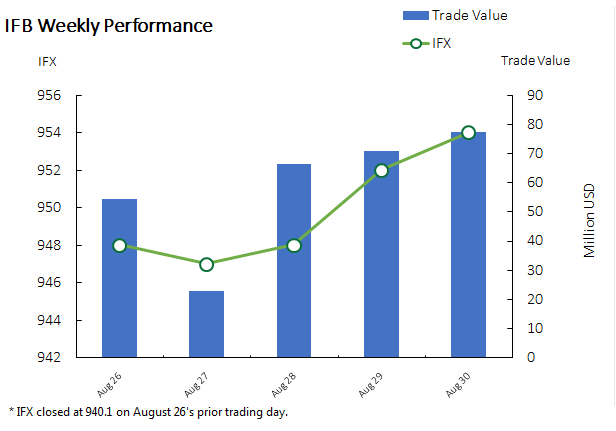Tehran Stock Exchange’s main index TEDPIX gained 731 points or 0.9% during the week that ended August 30 to close at 83,272.9.
Trading at Iran’s stock markets starts on Saturday and ends on Wednesday.
The main index of the smaller over-the-counter exchange Iran Fara Bourse IFX won 13.4 points or 1.4% during the week to end at 953.5. The index has extended its all-time high record for about two weeks now.
Over 4.53 billion shares valued at $342.4 were traded on TSE last week. The number of traded shares and trade value dropped by 33% and 6.2% respectively.
TSE’s First Market Index gained 746 points or 1.28% to end at 58,641.1. The Second Market Index rose by 324 points or 0.18% to close at 179,918.3.
At IFB, more than 1.72 billion securities valued at $291.7 million were traded. The number of traded shares and trade value surged by 116% and 101% respectively compared to the previous week. IFB’s market cap gained $323.8 million or 1.2% to reach $27.67 billion.
Its First Market witnessed the trading of 311 million securities valued at $15.51 million, indicating a 296% and 309% jump in the number of traded securities and trade value respectively.
About 793 million securities valued at $63.08 million were traded in the Second Market, with the number of traded securities and trade value growing by 70% and 71% week-on-week respectively.
Over 7 million debt securities valued at $172.33 million were also traded at IFB. The number of bonds traded and trade value jumped by 117% and 51% respectively.
Sukuk Trading Returns to Capital Market
The Central Bank of Iran finally stepped in last week and put a stop to the trading of the so-called Sakhab bonds by banks and delegated them to the Securities and Exchange Organization.
Sakhab is one of the many types of debt securities issued by the government meant to clear its debts to banks, contractors and municipalities. There are seven types of them, with maturity periods ranging from eight to 24 months. Each Sakhab bond is priced at 1 million rials ($26.1) per bond. They could only be traded in certain branches of Bank Melli Iran.
Things seem to have come full circle, considering that the SEO had previously refused to accept more Islamic Treasury Bills in the capital market in March and the government decided to sell them through banks.
In a letter publicized on Tuesday, CBI’s head of Credit Department, Ali Asghar Mirmohammad-Sadeqi announced that “banks and credit institutions are no longer allowed to participate in the secondary trading of Islamic bonds”.
The government started issuing bonds for its debts to contractors in 2015 and they were exclusively traded on over-the-counter-market Iran Fara Bourse. But that was only until this year’s March when the bonds’ high rates and low risk made them into a rival to equities and the government was pressured to refrain from issuing more.
In a controversial move, the government issued 120 trillion rials ($3.13 billion) of Sakhab bonds in late March and handed over the secondary trading to banks. The opaque condition of secondary trading prompted the mushroom-like growth of a black market and eventually gave rise to a more severe condition.
Cash-starved contractors largely cannot afford to wait for the bonds to mature so they start looking for someone to sell at a discount. Then come along shady dealers, buying them 30-37% lower than their face-value and either selling them at higher rates or cashing in on their yields. Sakhab’s return to IFB is meant to regulate the process.
Interest Rates Cuts Unlikely to Help Capital Market
Despite the interest rate cuts, none of the other sectors of the economy is capable of competing with the money market in liquidity attraction, said Central Bank of Iran Governor Valiollah Seif.
“Reducing deposit rates to 15% will not cause liquidity to flow into other markets, as none of them is capable of outperforming such returns,” said the official during an interview with IRINN on Wednesday.
CBI recently announced a directive mandating all banks and credit institutions to set their annual and fixed interest rates at 15% and 10% respectively by August 26.
All deposits made after the motion went into effect were affected and non-compliers were warned of penalization.
The rates were already cut in June, as the Money and Credit Council approved the cuts and CEOs of private and state-owned banks agreed to lower long-term deposit rates from 18% to 15% with short-term rates set at approximately 10%.
However, many lenders failed to comply, with rates reaching 22% plus when hidden fees were accounted for.
This is while banks have already taken measures to retain their higher deposit rates before the deadline.
According to Iran Chamber of Commerce, Industries, Mines and Agriculture, banks have asked depositors to close their previous accounts and open new ones to get higher rates for at least one more year.


